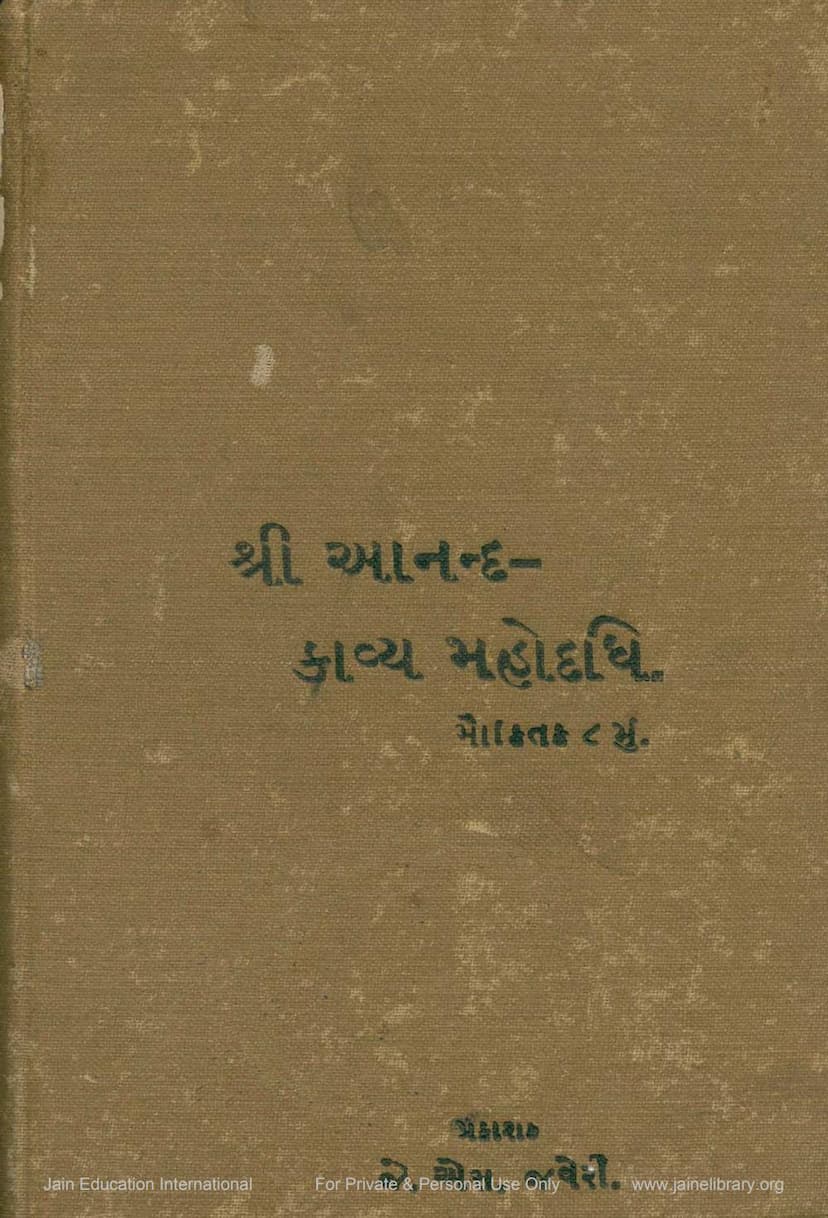Anand Kavya Mahodadhi Part 8
Added to library: September 1, 2025

Summary
Here's a comprehensive summary of the Jain text "Anand Kavya Mahodadhi Part 8," based on the provided pages:
Book Title: Anand Kavya Mahodadhi Part 8 Author(s): Muni Shree Sampatvijay (Compiler and Researcher) Publisher: Sheth Devchand Lalbhai Jain Pustakoddhar Fund Catalog Link: https://jainqq.org/explore/004842/1
Overall Purpose: This volume, Part 8 of the "Anand Kavya Mahodadhi" series, is a collection of ancient Jain poems (Gujarati) preserved and presented by the Devchand Lalbhai Jain Pustakoddhar Fund. The series aims to bring to light and make accessible valuable literary works from Jain tradition. This particular volume is dedicated to the works of the poet Rishabhdas, with a significant portion dedicated to his rendition of the "Kumarapal Ras."
Key Components and Contents:
-
Introduction (Prastavak) by Balwantray Kalyanray Thakore:
- Thakore's extensive introduction discusses the importance of studying Jain literature for understanding Gujarati literary history and the contributions of Jain scholars.
- He traces the evolution of Gujarati literature into three periods: the ancient flow (predominantly Jain), the middle flow (like Premanand and Samal), and the modern flow (starting from Narmad and Dalpatram).
- He highlights the distinct contributions of the Jain stream to literature, including its focus on stories of female ingenuity and its role in preserving traditional literary forms like the "Ras."
- Thakore also emphasizes the historical context of religious and sectarian divides that impacted the dissemination of knowledge, making much of the Jain literary heritage inaccessible to the wider public. He notes the positive shift in modern times towards a more inclusive appreciation of literature regardless of religious affiliation.
- He also touches upon the cultural impact of the Mughal era, particularly Emperor Akbar's reign, and its interaction with Jain scholars like Hirvijaysuri.
-
Kumarapal Ras (by Kavi Rishabhdas):
- This is the central piece of the volume. The text presents the "Kumarapal Ras," a narrative poem detailing the life and virtues of King Kumarapal, a significant figure in Jain history who converted to Jainism.
- The poem is based on the "Kumarapal Prabandh" by Jinmandan Muni and other traditional accounts. Rishabhdas explains his methodology, incorporating elements from scriptures, ethical texts, and oral traditions, while acknowledging his reliance on the Guru's teachings.
- The text includes detailed insights into the social, economic, and cultural life of Gujarat during the 17th century, particularly focusing on the prosperous city of Khambhat (Cambay), as described by Rishabhdas. The descriptions cover clothing, jewelry, trade, and religious practices.
- Rishabhdas's poetic style is noted for its sweetness, effectiveness, and ability to connect with the common people, drawing parallels to the works of contemporary poets like Prem Anand and Samal Bhatt.
- The volume includes lengthy discussions and detailed excerpts from Rishabhdas's works, demonstrating his skill in painting vivid pictures of daily life, societal norms, and the historical context.
-
Details about Poet Rishabhdas:
- The compilation provides biographical details about Kavi Rishabhdas, highlighting that he was a lay poet (shravak) from Khambhat.
- His estimated period of activity is around the 17th century, with his works dating from Samvat 1665 to 1690.
- The text mentions his lineage, with his grandfather Mahiraj being a wealthy merchant and his father Sanghan also being a respected Shravak.
- It is noted that Rishabhdas was financially well-off, which likely allowed him to dedicate his life to literary pursuits.
- His adherence to Jain principles as a lay follower is evident in his extensive writings, which often reflect his devotion and adherence to Jain conduct.
- The compilation lists a significant number of Rishabhdas's works, including various "Rasas" (narrative poems on religious and historical themes), stotras (hymns), and other literary pieces, showcasing his prolific output and contribution to Jain literature.
- The text also suggests a possible connection or influence between Rishabhdas and other prominent poets of his time, noting similarities in style and thematic elements.
-
Historical and Literary Context:
- The volume places Rishabhdas within the broader context of Gujarati literature, emphasizing the rich tradition of Jain literary contributions that predated and influenced later poets.
- The compiler, Muni Sampatvijay, is credited with diligently collecting and researching these ancient manuscripts, often from various Bhandars (Jain libraries), to bring them to print.
- The introduction by Balwantray Kalyanray Thakore offers a scholarly perspective on the literary periods and the significance of preserving such historical texts.
-
Dedication and Patronage:
- The volume is published by the Devchand Lalbhai Jain Pustakoddhar Fund, an organization dedicated to preserving and publishing Jain scriptures and literature.
- The compiler, Muni Shree Sampatvijay, is lauded for his extensive research and effort in compiling and editing this volume.
- The volume also includes a dedication to "Yoganishth Shrimad Buddhisagar Surishwarji," recognizing his influence and efforts in bringing ancient Jain works to light.
-
Cultural Insights:
- The "Kumarapal Ras" and other poems provide valuable ethnographic information about the customs, beliefs, and daily life of people in Gujarat during the 17th century.
- The meticulous descriptions of clothing, customs, and social interactions offer a window into the past.
Overall Significance:
"Anand Kavya Mahodadhi Part 8" is a significant scholarly undertaking that resurrects and makes available the poetic works of Rishabhdas, particularly his "Kumarapal Ras." It contributes to the understanding of ancient Jain literature, its stylistic evolution, and its role in shaping Gujarati literary history. The volume serves as a testament to the dedication of the Devchand Lalbhai Jain Pustakoddhar Fund and Muni Sampatvijay in preserving and disseminating this cultural heritage.